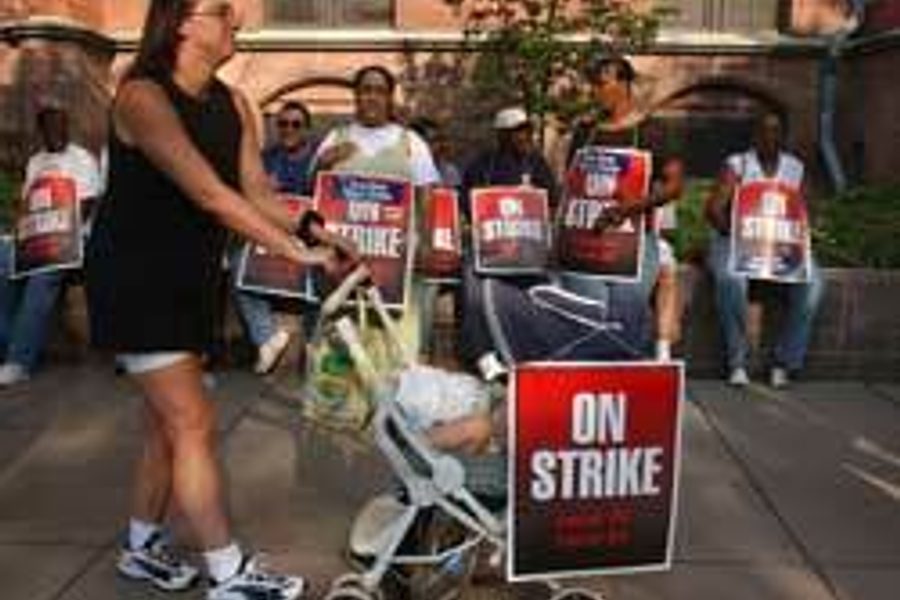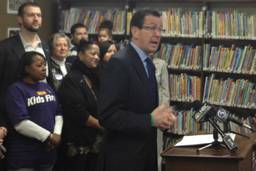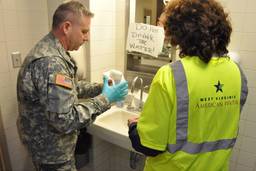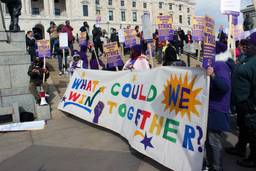
Angela Aponte’s job at Yale University was to help break a strike. Instead, she and 12 other Latino replacement workers walked off their jobs on September 12, and helped members of Locals 34 and 35 of the Hotel Employees and Restaurant Employees (HERE) win their struggle for higher wages, improved job security and decent pensions. These locals represent Yale’s 3,000 clerical and technical workers and 1,100 dining hall and maintenance workers.
Aponte’s determination to “fight for something I believe in rather than work for somebody and be a slave, where they disrespect me,” boosted HERE’s campaign to put Yale on the defensive. The replacement workers’ walk-out followed criticism from 25 mostly Hispanic members of Congress that Yale had hired few Hispanic workers before the strike and that its action “set the stage for a racially explosive situation,” since the scabs were escorted through a picket line of mostly African-American strikers.
The two HERE locals built a series of alliances with city officials, area clergy, and Yale students, staff and faculty.
National support also played a crucial role. HERE national President John Wilhelm was joined by national presidents of three other unions and AFL-CIO President John Sweeney, for a massive “Labor Goes to Yale” rally on September 13. Ten thousand union members and supporters showed up for the rally at which 152 people were arrested for civil disobedience, including all the national labor leaders.
It was clear from day one of this strike that pensions were the top issue. Before a settlement agreement ended the strike that began on August 27, the average pension for those with 20 years or more of service was $621 a month. The administration claimed that after 30 years at Yale, and factoring in Social Security payments, employees could retire on up to 91 percent of their after-tax income. The unions countered that those numbers applied to a “mythical worker”—one who requests no survivor benefits, has paid into Social Security from the age of 18, and has contributed to his or her own retirement plan.
The pension issue was highlighted when, on the eve of the strike, five Yale retirees took over the university’s investments office and demanded—and after a one-day sleep-in, got—a meeting with David Swenson, the financial guru who has managed to continually increase Yale’s endowment, which now stands at $11 billion. The retirement fund currently has a $200 million surplus, and protesters respectfully demanded that retirees get a bigger share. They walked out of the office to the cheers and hugs of a thousand union members and students, led by Jesse Jackson Sr., who spent the first week of the strike in New Haven.
In the settlement, union members won wage increases of 3 percent to 5 percent in each year of the contract (the average salary is currently about $30,000, after a decade of service), better job security, and a new step at the top of the job ladder for clerical and technical workers. They won two-thirds of retroactive wages lost in the past 19 months since their last contracts expired. And all workers got what one union spokesman called a “slam dunk victory” on pensions, almost doubling the amount that most workers will retire on. Existing benefits will continue, including full coverage of family health insurance, several weeks of paid time off, and help with college tuition and home purchase in certain New Haven neighborhoods.
The Yale administration gained one concession: they pushed to get an eight-year contract, while the locals—whose members approved the contract nearly unanimously—had originally proposed a four-year agreement.
Right up to the final day of the strike, university spokesman Tom Conroy dismissed the office takeover, the rallies and civil disobedience as publicity stunts, and said the unions should worry more about the fact that only half the clerical and technical workers went out on strike.
But that’s the way it’s always been, ever since Local 34 was organized in 1984. With more than 90 percent of Local 35 members out on strike, the locals had the critical mass they needed—along with financial, physical and moral support from labor around the country—to prevail.
The multi-tiered coalition building in New Haven also is in use elsewhere. HERE President Wilhelm said that building such labor-community coalitions is the only sure path to success.
Aponte’s determination to “fight for something I believe in rather than work for somebody and be a slave, where they disrespect me,” boosted HERE’s campaign to put Yale on the defensive. The replacement workers’ walk-out followed criticism from 25 mostly Hispanic members of Congress that Yale had hired few Hispanic workers before the strike and that its action “set the stage for a racially explosive situation,” since the scabs were escorted through a picket line of mostly African-American strikers.
The two HERE locals built a series of alliances with city officials, area clergy, and Yale students, staff and faculty.
National support also played a crucial role. HERE national President John Wilhelm was joined by national presidents of three other unions and AFL-CIO President John Sweeney, for a massive “Labor Goes to Yale” rally on September 13. Ten thousand union members and supporters showed up for the rally at which 152 people were arrested for civil disobedience, including all the national labor leaders.
It was clear from day one of this strike that pensions were the top issue. Before a settlement agreement ended the strike that began on August 27, the average pension for those with 20 years or more of service was $621 a month. The administration claimed that after 30 years at Yale, and factoring in Social Security payments, employees could retire on up to 91 percent of their after-tax income. The unions countered that those numbers applied to a “mythical worker”—one who requests no survivor benefits, has paid into Social Security from the age of 18, and has contributed to his or her own retirement plan.
The pension issue was highlighted when, on the eve of the strike, five Yale retirees took over the university’s investments office and demanded—and after a one-day sleep-in, got—a meeting with David Swenson, the financial guru who has managed to continually increase Yale’s endowment, which now stands at $11 billion. The retirement fund currently has a $200 million surplus, and protesters respectfully demanded that retirees get a bigger share. They walked out of the office to the cheers and hugs of a thousand union members and students, led by Jesse Jackson Sr., who spent the first week of the strike in New Haven.
In the settlement, union members won wage increases of 3 percent to 5 percent in each year of the contract (the average salary is currently about $30,000, after a decade of service), better job security, and a new step at the top of the job ladder for clerical and technical workers. They won two-thirds of retroactive wages lost in the past 19 months since their last contracts expired. And all workers got what one union spokesman called a “slam dunk victory” on pensions, almost doubling the amount that most workers will retire on. Existing benefits will continue, including full coverage of family health insurance, several weeks of paid time off, and help with college tuition and home purchase in certain New Haven neighborhoods.
The Yale administration gained one concession: they pushed to get an eight-year contract, while the locals—whose members approved the contract nearly unanimously—had originally proposed a four-year agreement.
Right up to the final day of the strike, university spokesman Tom Conroy dismissed the office takeover, the rallies and civil disobedience as publicity stunts, and said the unions should worry more about the fact that only half the clerical and technical workers went out on strike.
But that’s the way it’s always been, ever since Local 34 was organized in 1984. With more than 90 percent of Local 35 members out on strike, the locals had the critical mass they needed—along with financial, physical and moral support from labor around the country—to prevail.
The multi-tiered coalition building in New Haven also is in use elsewhere. HERE President Wilhelm said that building such labor-community coalitions is the only sure path to success.
Melinda Tuhus is an independent journalist with 25 years of experience in print and radio, including In These Times, The New York Times, Free Speech Radio News and public radio stations.









